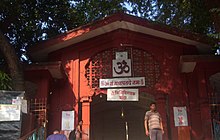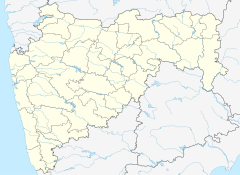
Trimbakeshwar Shiva Temple is an ancient Hindu temple in the town of Trimbak, in the Trimbakeshwar tehsil in the Nashik District of Maharashtra, India, 28 km from the city of Nashik and 40 km from Nashik road. It is dedicated to Hindu god Shiva and is one of the twelve jyotirlingas where the Hindu genealogy registers at Trimbakeshwar, Maharashtra are kept. The origin of the sacred Godavari river is near Trimbak.
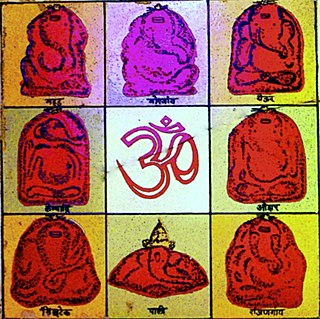
Ashtavinayaka is a Sanskrit term which means "eight Ganeshas". The Ashtavinayaka yatra trip refers to a pilgrimage to the eight Hindu temples in the state of Maharashtra, India, centered around the city of Pune, that house eight distinct idols of Ganesh, in a pre-ascertained sequence. Ganesh is the Hinduism/Hindu deity of unity, prosperity, learning, and removing obstacles. Each of these temples has its own individual legend and history, as distinct from each other as the murtis in each temple. The form of each murti of Ganesh and his trunk are distinct from one another. There are other temples of eight Ganesh in various other parts of Maharashtra; however, the ones around Pune are more well known and visited. It is believed that to complete the Ashtavinayak Yatra, one must revisit the first Ganpati after visiting all the eight Ganpatis.
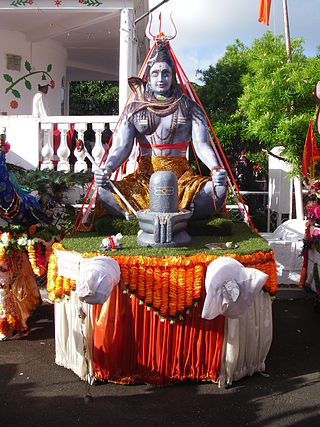
Maha Shivaratri is a Hindu festival celebrated annually in honour of the deity Shiva, between February and March. According to the Hindu calendar, the festival is observed on the fourteenth day of the dark (waning) half of the lunar month of Phalguna or Magha. The festival also commemorates the wedding of Shiva and Parvati, and the occasion that the Shiva performs his divine dance, called the Tandava.
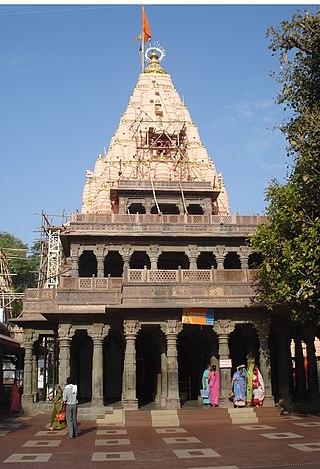
Mahakaleshwar Jyotirlinga is a Hindu temple dedicated to Shiva and is one of the twelve Jyotirlingas, shrines which are said to be the most sacred abodes of Shiva. It is located in the ancient city of Ujjain in the state of Madhya Pradesh, India. The temple is situated on the side of the holy river Shipra. The presiding deity, Shiva in the lingam form is believed to be Swayambhu, deriving currents of power (Shakti) from within itself as against the other images and lingams that are ritually established and invested with mantra-shakti.
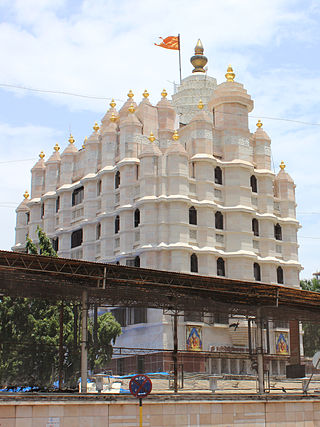
The Shree Siddhivinayak Ganapati Mandir is a Hindu temple dedicated to Lord Shri Ganesh. It is located in Prabhadevi, Mumbai, Maharashtra, India. It was originally built by Laxman Vithu and Deubai Patil on 19 November 1801. It is one of the richest temples in India.

Tripura Sundari Temple is a Hindu temple of the Goddess Tripura Sundari, better known locally as Devi Tripureshwari. The temple is situated in the ancient city of Udaipur, about 55 km from Agartala, Tripura and can be reached by train and road from Agartala. It is believed to be one of the holiest Hindu shrines in this part of the country and witnesses the highest number of visitors for a temple in North-East India, after Kamakhya Temple in Assam. The state of Tripura is named after this temple. Popularly known as Matabari, the shrine is set upon a small hillock that resembles the hump of a tortoise (Kurma). This shape called Kurmapṛṣṭhākṛti is considered the holiest possible site for a Shakti temple, hence also bestowing the name of Kurma Pīṭha. The Goddess is served by traditional Brahmin priests.

Shri Shantadurga Saunsthan is a private temple complex belonging to the Goud Saraswat Brahman Samaj located 30 km (19 mi) from Panaji at the foothill of Kavalem village in Ponda Taluka, Goa, India.

Kumara Swamy Devasthana, also known as Sri Kumaraswaami Temple, is a Hindu temple located in Hanumanthanagar, in the city of Bangalore, Karnataka, southern India. It is dedicated to the god Kartikeya, also known as Subrahmanya, Kumara Swamy, or Murugan.
The Dashabhuja Temple is a Hindu temple in Pune, in the Maharashtra state of India. This temple was once owned by Sardar Haripant Phadke, a Sardar of Peshwa and was later donated to the Peshwas as dowry. Dashabhuja Ganapati temple is visited by thousands of devotees every day and the number increases during Ganesh Chaturthi. The idol of Ganpati or Ganesh seen here has his elephant trunk resting on his right-hand side, which is supposed to be rarer and more sacred than other forms of the Ganesh idol.
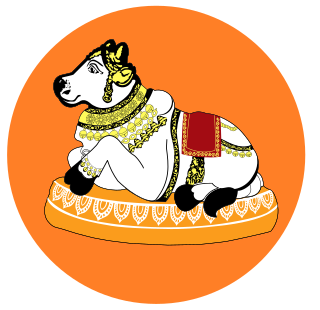
Pradosha or Pradosham is a bimonthly occasion on the thirteenth day of every fortnight in the Hindu calendar. It is closely connected with the worship of the Hindu god Shiva. The auspicious three-hour period 1.5 hours before and after sunset is considered as the most suited and optimal time for worship of Shiva on this day. The fasting vow performed during the period is called "Pradosha vrata". A devotee should wear rudraksha, Vibhuti and worship Shiva by abhisheka, sandal paste, bael leaves, fragrance, deepa and naivedya.

The Shree Vajreshwari Yogini Devi Mandir is a Hindu temple dedicated to the goddess Vajreshwari, located in the town Vajreshwari, 75 km away from Mumbai. The town, earlier known as Vadvali, was renamed Vajreshwari in honour of the presiding deity of the temple.
The following are the temples located in and around Hyderabad

Annapurna, Annapurneshwari, Annada or Annapoorna is a manifestation of Parvati and is known as the Hindu Goddess of food and nourishment. Worship and offering of food are highly praised in Hinduism, and therefore, the Goddess Annapurna is regarded as a popular deity. She is a manifestation of the Goddess Parvati, the wife of Shiva, and is eulogized in the Annada Mangal, a narrative poem in Bengali by Bharatchandra Ray. The Annapurna Sahasranam is dedicated to the Goddess and praises her one thousand names, while the Annapurna Shatanama Stotram is dedicated to her 108 names.

Aundha Nagnath, one of the 12 Jyotirlingas, is a sacred pilgrimage site in Hingoli district. temples mentioned in the Shiva Purana and is one of the twelve Jyotirlingas. It is located in Hingoli Maharashtra, India.

The Siddhivinayaka Mahaganapati Temple is a Hindu temple located in Titwala, a small town in the Kalyan taluka of Thane district – near Mumbai, Maharashtra, India. The temple is dedicated to the Hindu, elephant-headed god of wisdom Ganesha. Titwala is believed to be the putative site of the hermitage of sage Kanva, foster parent of Shakuntala who was born here. The place is steeped in ancient legend and the temple is frequented by a very large number of devotees on account of the belief that separated married couples could be united and marriages of desired people could be fixed easily if the Ganesha image installed in the temple is worshipped with devotion.This temple is frequented mostly on Tuesdays.

Ganesh Jayanti (literally "Ganesha's birthday", also known as Magha shukla chaturthi, Tilkund chaturthi, and Varad chaturthi, is a Hindu festival. This occasion celebrates the birth day of Ganesha, the lord of wisdom. It is a popular festival particularly in the Indian state of Maharashtra and it is also celebrated in Goa held during the shukla paksha chaturthi day in the month of Maagha as per almanac, which corresponds to the Gregorian calendar month of January/February. In 2022, Shri Ganesh Jayanti falls on 4 February.

Shri Mayureshwar Mandir or Shri Moreshwar Temple is a Hindu temple (mandir) dedicated to Ganesha, god of wisdom. It is located in Moragaon in Pune District, about 65 km away from Pune city in the Indian state of Maharashtra. The temple is the starting and ending point of a pilgrimage of eight revered Ganesha temples called Ashtavinayaka.

The Siddhivinayak Temple of Siddhatek is a Hindu temple dedicated to Ganesha, the elephant-headed god of wisdom. The temple is one of the Ashtavinayaka, the eight revered shrines of Ganesha in the Indian state of Maharashtra and the only Ashtavinayaka shrine in Ahmednagar district.
The temple of Shree Balaji Mandir is located at Charkop, Kandivali (West). It is claimed to be the second home place of lord venkateshwara after Tirupati Temple.
The Shree Vinayaka Devaru is a Hindu temple dedicated to the god Ganesha, It is one of the tourist destination near Murudeshwara, it is located on the West Coast of India in the Idagunji town in Uttara Kannada district in Karnataka. The temple's popularity as a religious place is recorded by about 1 million devotees visiting it annually.
